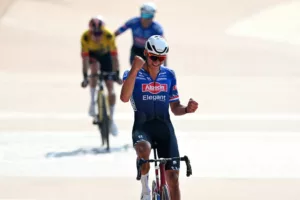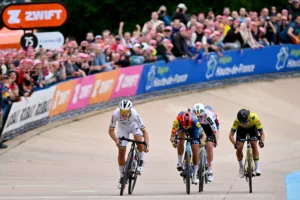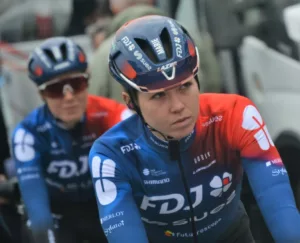The Paris-Roubaix, often dubbed the “Hell of the North,” is not just a cycling race; it’s a monument to the enduring spirit of cycling. This event, with its treacherous cobblestone sections and gruelling distance, has tested the mettle of cyclists since 1896. The introduction of Paris-Roubaix Femmes in recent years has added a new chapter to this storied race, celebrating the same spirit of endurance among women cyclists.
Table of Contents
ToggleBeyond the race itself, one of the most iconic symbols of Paris-Roubaix is the legendary showers at the Roubaix Velodrome. These showers, with their simple, tiled cubicles, are far more than just a place for riders to wash off the grime of the race. Each cubicle bears a plaque with the name of a previous winner, creating a tangible link to the race’s rich history. For riders and fans alike, these plaques are a badge of honour, symbolising triumph over one of cycling’s most challenging events. The tradition of adding a winner’s name to a shower cubicle underscores the personal and historical significance of winning Paris-Roubaix, making the showers a hallowed hall of fame for the cycling elite.

The Showers: A Hall of Fame
The showers at the Roubaix Velodrome represent more than just a place to clean up; they are a shrine to the legends of Paris-Roubaix. The sight of these tired, mud-splattered warriors washing away the toil of the race, under plaques bearing the names of the giants of the sport, is profoundly moving. It’s a moment of vulnerability and pride, a personal connection between the champions of today and those of yesteryears. The tradition of the plaques began as a way to honour the victors, but over time, it has grown to symbolise the essence of Paris-Roubaix itself: perseverance, resilience, and the sheer will to overcome. Having one’s name immortalised on a plaque in the showers is a dream for many riders, a symbol that they have conquered the “Hell of the North” and earned their place among the legends of the sport.
In the aftermath of Paris-Roubaix, the showers of the Roubaix Velodrome transform into a stage where the day’s battle is both concluded and commemorated. It is here, in this unassuming backdrop, that the most compelling narratives of human endurance and resilience are captured. The post-race photographs of riders, their faces etched with the day’s exertions, offer a window into the soul of the sport, immortalising the riders’ hurt, suffering, and ultimately, their triumph over one of cycling’s most formidable challenges.

(Photo credit: Jojo Harper)
These images, stark and unfiltered, convey a raw emotion seldom seen in the polished world of professional sports. They tell stories of individual struggles, of moments when the spirit was tested, and the body was pushed beyond limits. The mud, the sweat, and the tears that are washed away in the showers are symbols of the hardships endured on the cobbled paths of the Hell of the North. Yet, amidst this vulnerability, there is an overwhelming sense of pride and accomplishment. The riders, in their most broken state, are at their most beautiful, embodying the paradox of human resilience: that true strength is often revealed in moments of complete surrender.
The plaques in each shower cubicle serve as silent witnesses to these moments of catharsis. For the riders, to be photographed beneath the name of a past victor is to be linked to the timeless legacy of Paris-Roubaix. It’s a visual and spiritual affirmation that their pain, their efforts, and their story have added another layer to the rich tapestry of the race’s history. These images, shared with the world, become icons of endurance, inspiring awe and admiration from fans and aspiring cyclists alike.
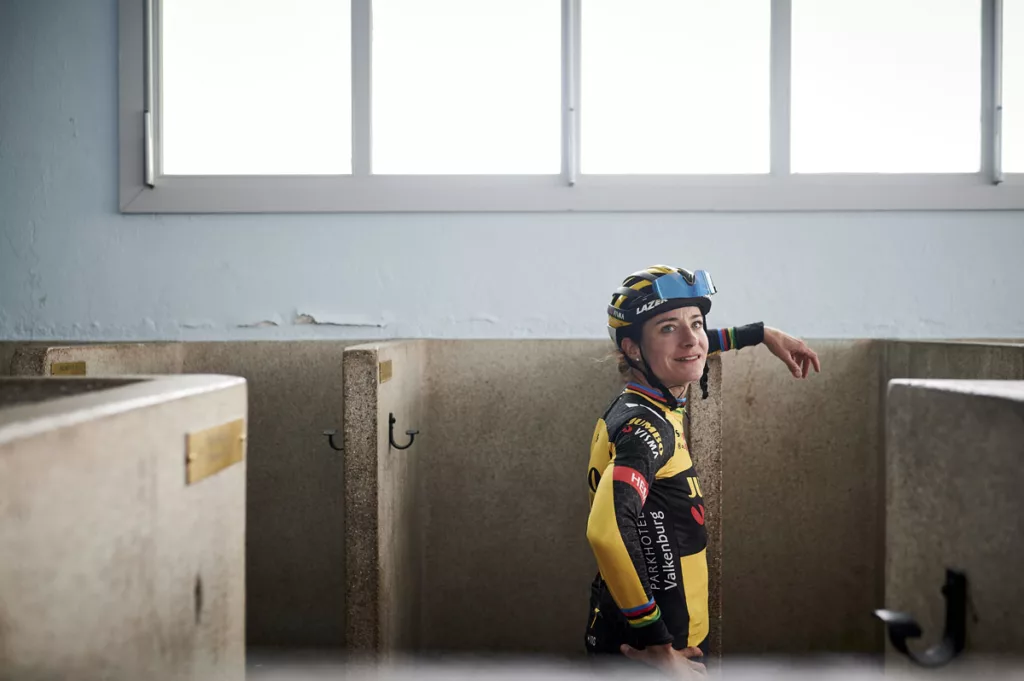
(Photo Credit:Bram Berkien/Team Jumbo Visma)
Rider Plaques in the Roubaix Velodrome Showers
The Roubaix Velodrome showers are steeped in history, with each plaque a testament to the enduring legacy of the storied Paris-Roubaix race.
Francesco Moser, an Italian powerhouse, holds a position of honour, his three successive victories immortalised on the walls of this hallowed ground. Adjacent to him is Felice Gimondi, a compatriot whose versatility across cycling disciplines brought him to the podium of all three Grand Tours. Alongside these Italian legends is the plaque of Octave Lapize, the tenacious 1910 Tour de France winner, who was as much a hero on the cobblestones as he was on the Tour’s mountain passes.
Roger De Vlaeminck, etched into the race’s folklore as “Monsieur Paris-Roubaix” for his record four victories, is nestled between the names of Pino Cerami, the oldest rider to win the race, and Eric Derycke, whose own accomplishments in the professional peloton are commemorated in stone.
In a row that speaks to the lionhearted spirit of the race, the cubicle of Johan Museeuw nicknamed the ‘Lion of Flanders’ for his fierce dominance, stands in proximity to Albert De Jonghe, a name that may not echo as loudly but is nevertheless engraved in the fabric of the race. Next to Museeuw is the plaque of Peter Post, a former Paris-Roubaix winner who, with his own steely resolve, became one of the most successful team directors in cycling history.
Finally, the cubicle of Gilbert Duclos-Lassalle represents a career that blossomed with age, culminating in two Paris-Roubaix victories. He is flanked by John Degenkolb, whose triumph in 2015 was a narrative of resilience and determination, and Emiel Van Hevel, a nod to the bygone era of the race, his successes adding to the tapestry of its history.
These pairings are more than a mere alignment of tiles; they are a sequence of stories, a dialogue between the past and the present, with each plaque a chapter in the enduring saga of the Paris-Roubaix.
Memorable Names Immortalised
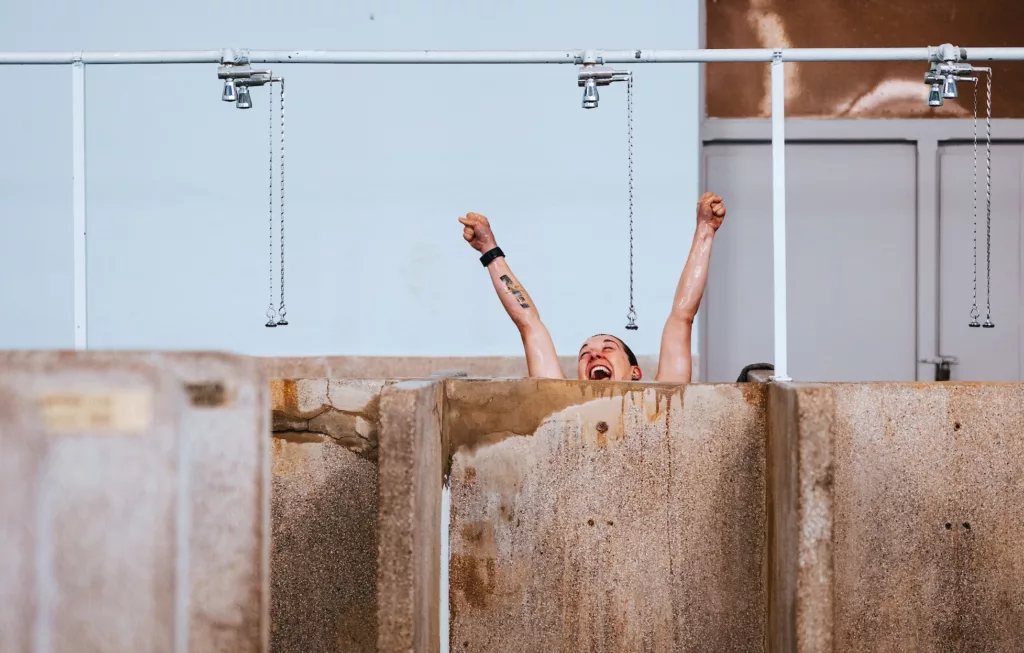
Alison Jackson
Alison Jackson’s victory in the 2023 Paris-Roubaix Femmes was a remarkable display of sheer determination. Known for her gritty racing style and TikTok dancing moves, Jackson approached the race with a well-devised plan. Right from the outset, Jackson positioned herself wisely within the peloton by getting into the early break of the day. The break worked well together and took a big lead but not one that looked like it would survive to the end.
As the kilometres ticked down, Jackson remained alert to the movements of her rivals, ensuring she was well placed to cover attacks and make her presence felt in the lead group. The decisive moment for Jackson came in the latter stages of the race when the lead group had been whittled down to a select few contenders, each capable of claiming the victory.
Entering the velodrome all eyes were on the likes of Femke Markus or Marthe Truyen with Jackson expected to do ok but not necessarily win. However, Markus would crash on the track when her wheels slid out and recognising the perfect moment to launch her sprint, Jackson unleashed a powerful acceleration that caught her rivals off guard. Her timing and speed were unmatched, propelling her across the finish line first and earning her a monumental victory. In shock as she crossed the line, by the time Jackson stepped off the bike it was time for a celebratory dance.

Mathieu van der Poel
Mathieu van der Poel’s triumph in the 2023 Paris-Roubaix was a showcase of strength, strategic insight, and indomitable spirit, affirming his status as one of the most gifted cyclists of his era. Van der Poel, renowned for his bold racing approach and capability across a range of cycling disciplines, entered Paris-Roubaix with a clear plan and the confidence to execute it flawlessly.
From the start, van der Poel was a dominant force in the race, demonstrating exceptional bike-handling skills and power across the cobbled sectors that are the hallmarks of the Hell of the North. Paris-Roubaix, notorious for its challenging cobbled stretches, tests the endurance, skill, and resilience of every rider. Van der Poel’s adeptness at navigating these sectors allowed him to conserve energy, keeping him in an advantageous position throughout the event.
As the race unfolded, van der Poel executed several decisive moves, showcasing not only his physical prowess but also his tactical intelligence. His attacks were impeccably timed, compelling his rivals to react and steadily reducing the group of contenders. Van der Poel’s relentless pressure ensured that only the strongest riders remained in contention, setting up a thrilling climax.
In the race’s final stages, van der Poel was among a select group of riders with the potential to claim victory. His versatility as a cyclist was evident here; known for his sprinting capacity as well as his ability to sustain long solo efforts, van der Poel was ideally prepared for any race scenario. It was a combination of a strategically launched attack and his powerful sprint that clinched his victory. In the ultimate dash to the finish, van der Poel unleashed a formidable sprint that his competitors could not rival, crossing the line first to secure the prestigious cobblestone trophy.
Mathieu van der Poel’s victory at the 2023 Paris-Roubaix epitomised his racing ethos: courageous, assertive, and relentless. His win was not just a testament to his physical strength but also to his mental resilience and strategic acumen. Van der Poel’s performance at Paris-Roubaix added yet another significant chapter to his already distinguished career, confirming his place as one of the foremost classics specialists of his generation.

André Mahé and Serse Coppi’s Joint Win
The joint cubicle of André Mahé and Serse Coppi tells one of the most unusual stories in Paris-Roubaix history. The 1949 Paris-Roubaix featured one of the most remarkable and controversial finishes in the history of professional cycling, involving French cyclist André Mahé and Italian cyclist Serse Coppi, the younger brother of the legendary Fausto Coppi.
André Mahé was part of a breakaway group that led the race as it approached Roubaix. In the chaotic and poorly marked route of the final kilometres, the lead vehicle, which was supposed to guide the breakaway riders, took a wrong turn. Mahé and a few others followed the lead vehicle, mistakenly diverting from the official race route. They ended up at the velodrome, where the race was supposed to finish, but they entered through the wrong gate.
Meanwhile, Serse Coppi, who was trailing behind in what was thought to be the second group on the road, entered the velodrome through the correct route as per the race’s official course. Unaware of the error made by Mahé and his group, Coppi sprinted to the finish line, crossing it first among the riders who had taken the correct route.
The confusion led to an immediate uproar. André Mahé was initially declared the winner since he was the first to arrive at the velodrome, albeit by an incorrect route. However, protests from other teams, particularly from the Bianchi team, which included Serse Coppi, argued that Coppi had finished first according to the official route and therefore deserved to win.
After much deliberation, the decision was made to declare André Mahé the winner of the 1949 Paris-Roubaix. Nonetheless, the controversy did not end there. The decision was challenged, leading to a protracted dispute that lasted several months. Eventually, in a bid to resolve the situation equitably, the French Cycling Federation decided to recognise both André Mahé and Serse Coppi as winners of the 1949 Paris-Roubaix. This joint recognition continues to this day with a joint plaque in the Roubaix Velodrome showers.

(Photo Credit: ASO)
Mathew Hayman
Mathew Hayman’s victory in the 2016 Paris-Roubaix is one of the most inspiring underdog stories in the history of professional cycling. Just five weeks before the race, Hayman suffered a broken arm at that year’s Omloop Het Nieuwsblad, casting doubt on his ability to even participate in Paris-Roubaix, let alone compete at a high level.
Despite the significant setback, Hayman refused to let his Paris-Roubaix aspirations fade. He adapted his training regimen to accommodate his injury. He spent considerable time training on a stationary bike, including sessions on Zwift, to maintain his fitness without aggravating his broken arm which he balanced on a step ladder.
On race day, throughout the gruelling 257.5-kilometre race, Hayman stayed attentive and positioned himself in the day’s breakaway. Their supposedly doomed position also helped Haymen avoid the crashes and related mechanical issues that often decimate the peloton in the “Hell of the North.”
As the race entered its final stages, Hayman found himself in a select group of riders who having caught the break were all vying for victory. This group included Tom Boonen, a four-time Paris-Roubaix winner and one of the pre-race favourites. However, rather than being daunted, Hayman leveraged his extensive experience and deep knowledge of the race, gained over 15 previous participations, to outsmart his rivals in the closing kilometres. In a thrilling sprint finish on the velodrome track, Hayman utilised his track cycling experience to outpace his rivals, crossing the line first to secure a victory that was as unexpected as it was celebrated.
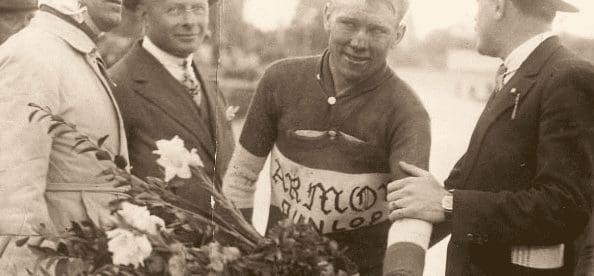
Julien Vervaecke
Julien Vervaecke’s career was marked by a notable controversy during the 1930 Paris-Roubaix, a race that would go down in history for its contentious outcome. With 65 kilometres remaining, Vervaecke launched a daring attack, a move that only Jean Marechal could match. Marechal, riding as an independent due to a fall-out with his previous team, found an unexpected ally in Vervaecke, as the two initially cooperated to distance themselves from the peloton.
However, the dynamics between the two front-runners took a strategic turn when Vervaecke received orders from his Alcyon team manager to conserve energy and let Marechal do the work. Complying with his manager’s directives, Vervaecke notably eased his efforts, even whistling behind Marechal, before launching an attack in an attempt to shake him off. Though Vervaecke momentarily gained ground, Marechal managed to close the gap with 6 kilometres to the race’s conclusion. In a dramatic twist, a clash between the two resulted in Vervaecke ending up in a ditch.
Despite Marechal crossing the finish line in Roubaix alone, behind-the-scenes manoeuvres by the Alcyon team manager led to a swift protest, demanding Marechal’s relegation for supposedly causing Vervaecke’s crash. The decision to relegate Marechal to second place, rather than disqualify him, raised eyebrows, suggesting external influences, possibly from Belgian fans or the substantial advertising revenue Alcyon contributed to the race organisers, L’Auto. Marechal, feeling wronged by the decision, saw his supposed victory overshadowed by controversy.




